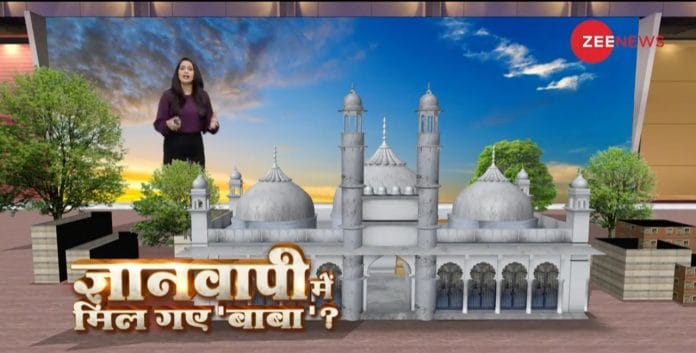Here’s a thought: maybe TV news channels ought to take a long, hard look at how they’ve been covering the Gyanvapi issue.
Advocate Commissioner Ajay Mishra was, summarily, withdrawn from any further role in the matter by a Varanasi court, because his videographer, allegedly, leaked footage and images of the Gyanvapi survey to the media. Shouldn’t the media have vetted the visuals that became available instead of simply telecasting them?
Should news channels have broadcast claims of the `Hindu side’ such as ‘Baba mil gaya’ (Zee News), ‘We have found what we were hoping for’ (TimesNow Navbharat), ‘Shivling found’ (NDTV 24×7), or running hashtags of their own, like #BabaMilGaya (Republic TV), #GyanvapiTruthFiles (India Today, Times Now, Republic TV) and declaring there was ‘Irrefutable Proof’ of a temple inside the Gyanvapi, besides hosting debates such as ‘Shivling Found Inside Gyanvapi. Is this a victory for Hindus?’ (Times Now) – what about making celebratory statements such as ‘Bam Bam Bole Varanasi’ (News 24)?
Doesn’t this amount to prejudice?
How is it that news channels can use unverified video footage and photographs to support certain claims and for Republic TV anchor Arnab Goswami to say that in the video the ‘shivling is clear’ – after shrugging off any impropriety in the leak of the video, saying dismissively ‘…the video has come out, now people may say why has the video come out, it should not have come out…’? Er, wasn’t it the Varanasi court which was anguished over this?
Also read: Bulldozer, Hanuman Chalisa, Taj Mahal, Mughal — Want to make TV headlines? Pick any
Influencing viewers
Since Monday (16 May) afternoon, we have been treated to a 360 degree view of a circular structure. This is, reportedly, a fountain inside Gyanvapi — with water, without water — but is now being identified as a shivling.
We are being shown photographs, purportedly, of walls of the Gyanvapi with signposts to point out reported carvings of Hindu gods (Times Now), or the temple’s structure (Aaj Tak). We are informed that the ‘Hindu side’ says there are a lot of Hindu symbols inside Gyanvapi — even a Ganesh statue (India TV). We have seen innumerable interviews with Hindus, sages, scholars, mahants, and citizens outside Gyanvapi, all of whom have given us gyaan that this is a temple, that there is a shivling inside Gyanvapi, etc.
TV news channels use repetition to hammer home a point: if you keep repeating something it becomes the `truth’. Thus the constant telecast of the ‘shivling’ and the inside of Gyanvapi, the numerous interviews make viewers believe that this is ‘Gyanvapi ka sach’ (News 24).
It may or may not be the truth, if there is such a thing in architectural history of monuments that have been raised and then razed for centuries, but that’s not the point: it is not for TV news channels to decide.
TV anchors and reporters, sanctimoniously said, Monday and Tuesday, that the court’s will be the final word on the dispute, but meanwhile, they do everything to influence viewers.
This is increasingly dangerous territory. As India Today reported Tuesday, there are other mandir-masjid disputes in Maharashtra, Madhya Pradesh, Gujarat, West Bengal besides Uttar Pradesh: will there be demands to open them up too? Will we begin to see videos of their fountains? Will each of them become a full blown Hindu-Muslim controversy, that plays out on television, inciting both sides?
That’s another worrying aspect of Gyanvapi. Till recently, it was an unwritten convention that an individual’s religion and caste should not be identified in the media unless absolutely necessary. Petitioners were identified as petitioners and respondents as respondents. Now, we hear and read the ‘Hindu side’ and the ‘Muslim side’ – Hindus say this and Muslims say that…
Perhaps this is a long overdue simplification — there is no hiding from the nature of the conflict. But is ‘War over worship taking over India?’ (India Today). Do news channels even begin to think about such implications of their telecasts?
Certainly, the lines that divide people are being deepened: the killing of a man in Baramulla, Jammu and Kashmir, was described by Republic TV as ‘Hindu killed in Valley’. India Today had described the same incident differently: ‘Rajouri resident killed’.
Also read: So happy Indians in Europe, so angry Indians back home – the two India stories on TV news
PM’s reporters
The habit of TV news to promote a certain perception doesn’t always achieve the desired effect. For instance, during Prime Minister Narendra Modi’s brief visit to Nepal, Monday, reporters’ efforts to feel the ‘josh’ fell rather flat.
On the streets of Lumbini, en route to the Mahadevi temple where the PM was to offer prayers, reporters mingled with schoolgirls who lined the streets to welcome him.
The India TV reporter said they were ‘very excited’ to see the PM but the girls simply stared at him or at the road, blankly. The Zee News reporter claimed there was ‘excitement’ written all over their faces but all we could see were expressionless faces.
Reporters from channels like Aaj Tak, Zee News, ABP News, India TV repeatedly asked the students, ‘did you see the PM (‘Dekha?’) and they replied, blandly, ‘Yes’.
‘Achcha laga?’ reporters asked again and again.’ Haan, achha laga,’ came the reply, each time. Really pressed by some reporters, a few girls added an adverb: ‘Bahut achha laga.’
Reporters are not the only ones to have their words or actions boomerang. Remember yesterday’s media stars Navneet and Ravi Rana? They were charged, jailed and subsequently released after they had threatened to recite Hanuman Chalisa outside the home of Maharashtra Chief Minister Uddhav Thackeray. In public and in the media, they were pakka Hanuman ji ke bhakt.
But when Times Now Navbharat anchor Navika Kumar asked Navneet, in an interview, how Hanuman got his name, she looked nonplussed. Clearly, she didn’t know the answer — all she could do was smile all her lovely teeth.
Ouch.
Views are personal.
(Edited by Prashant)






